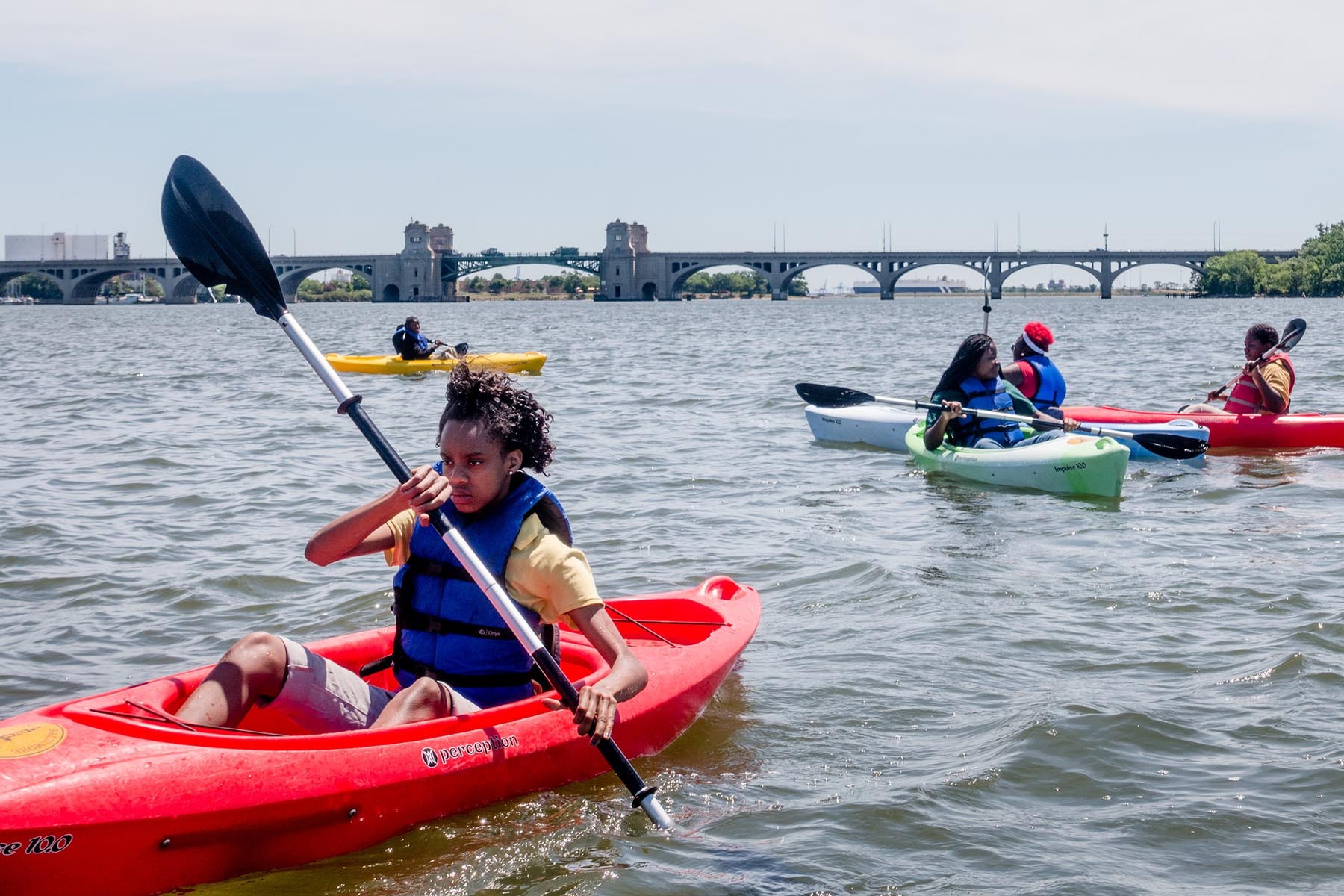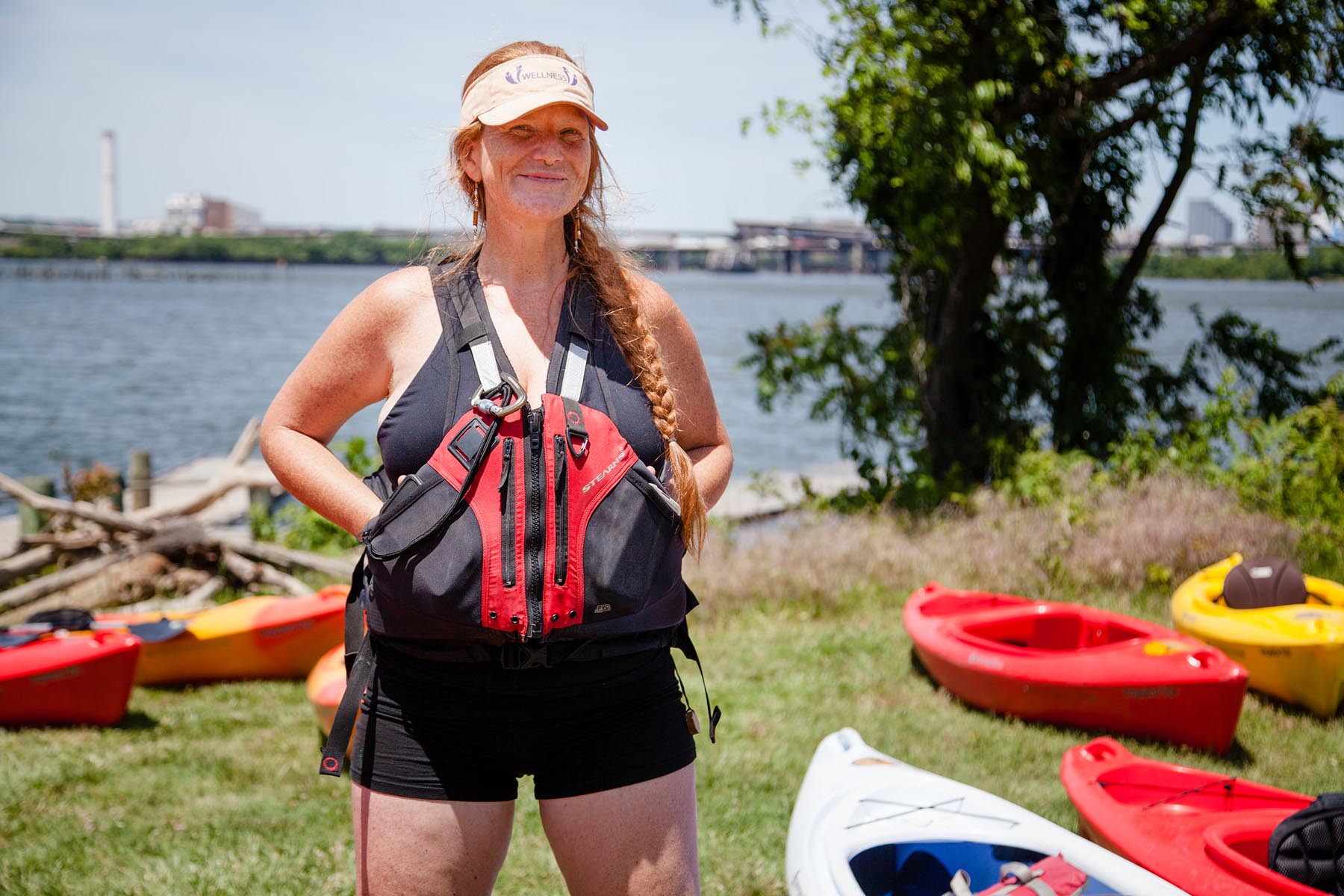At home, on the water in Baltimore
Kids in Kayaks pairs paddling with learning and stewardship for 500 eighth graders
On a June morning at Baltimore’s Middle Branch Park, a few steps from the Patapsco River, Molly Gallant addresses a group of eighth graders like a drill sergeant in a life vest.
“Hands up if this is your first time in a kayak, ever,” said Gallant, the high sun irradiating her tanned, freckled shoulders and red hair. Gallant, an Outdoor Recreation Programmer with Baltimore City Recreation and Parks, counted aloud six raised hands.
“For those of you that have not been out before, the secret to kayaking is pressing your knees to the sides, okay?” Gallant said. “And you let your hips rock with the water and your upper body stay straight.”
The few dozen students had come that morning from Collington Square Elementary School, located roughly two miles northeast of Baltimore’s Inner Harbor, for a program called Kids in Kayaks. In its first year, roughly 500 Baltimore students have taken part in the program, funded by the National Park Service and the Baltimore National Heritage Area. It has given many children their first experience on the water that has defined their hometown.
The program began with in-classroom orientation by staff from the National Park Service Chesapeake Bay Office.
“We went out to the schools beforehand to talk to students about what was going to happen,” said Kate Marks of the National Park Service. Marks said the overview also included discussion of “the history of the region and human impact on the landscape over the past 400 years.”
Participating schools then made two trips—in fall and spring—to the 150-acre park for entry-level kayak lessons taught by Gallant and other Recreation and Parks staff as well as on-land activities hosted by various partners including the National Park Service, the Maryland Zoo, the Star-Spangled Banner Flag House, and Fort McHenry National Monument and Historic Shrine.
“Every organization has their own mission, their own reason why they’re doing this,” Gallant said. “I think the common interest for all of us is that it’s really, really important to start engaging urban populations in the natural resources that are available to them.”
During the primer on water safety and paddling, expressions on the students’ faces ranged from giggles to frightened anticipation. A boy asked if there were any animals in the water.
“There is nothing the water that is going to eat you,” Gallant said, sensing the boy’s concern.

Gallant first talked with the National Park Service about the idea for Kids in Kayaks as an outdoor recreation program in order to get Baltimore children engaged in the historical, cultural, and ecological heritage of their hometown.
She said the environmental aspect is the first one the children pick up on.
“It’s this secret way of developing stewardship where you cannot go out on the water and have a good time and not start forming those connections,” Gallant said. “It makes you think twice about throwing litter on the ground.”
Previous trips have included Park Service sites along the Captain John Smith Chesapeake and Star-Spangled Banner National Historic Trails, including Ft. McHenry.
“You get to look out there and see this big massive green area that is Ft. McHenry—you get to see the flag flying out there,” Gallant said. “You get to see why this is important to Baltimore, why Baltimore was developed as a port town, why we are where we are.”
That day, as half of the children took to the water, the other half followed Peter Martin, a Naturalist at the Maryland Zoo in Baltimore, for a guided nature walk to learn about some of the animals and insects living at Middle Branch Park.
“We’ll see those same things out on the water,” Gallant said. “So it’s really very complementary.”

The trips are intended to be entry-level kayaking lessons, but Gallant has also seen a lot of personal growth in the children—something that was never written into the program.
“One of the young ladies that had come to us this spring was extremely fearful,” Gallant said. “It took us about 20 minutes to even get her in the boat. Tears. Anxiety. She just did not think that she could do it. So by the end of the trip, not only was she able to do it, she was actually towards the front of the pack. So that second trip for her—no hesitation.”
The newcomers from Collington Square struck a similar chord of confidence on the water.
“It happens in different variations on a lot of different levels with a lot of different kids,” Gallant said.
To view more photos, visit the Chesapeake Bay Program’s Flickr page
Video, photos and text by Will Parson

Comments
There are no comments.
Thank you!
Your comment has been received. Before it can be published, the comment will be reviewed by our team to ensure it adheres with our rules of engagement.
Back to recent stories